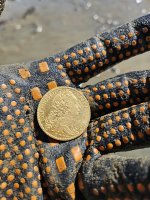- Thread starter
- #61
Tell me a good reason why I have such little water in my 15 ft hole not far from the mississippi river ??.
??.
And I might let it go. Why was there 12 fence posts at the top of the dig 18 inches down Why am I still digging topsoil out of the bottom of that hole
Why am I still digging topsoil out of the bottom of that hole ??
??
Why does our instruments still say theres something down there ?? Why is the lime thin on the edges and getting thicker as i move laterally
?? Why is the lime thin on the edges and getting thicker as i move laterally Why was there ever talk of treasure
Why was there ever talk of treasure
on that property ? Why does that talk go back so far and maybe even farther than I know
? Why does that talk go back so far and maybe even farther than I know ?? Here's one, when I probe side ways (diagonal) on to the thicker parts,
?? Here's one, when I probe side ways (diagonal) on to the thicker parts,
I get air bubbles, WHY
 give me reasonable answers and I might let it go.
give me reasonable answers and I might let it go.
 ??.
??.And I might let it go. Why was there 12 fence posts at the top of the dig 18 inches down
 Why am I still digging topsoil out of the bottom of that hole
Why am I still digging topsoil out of the bottom of that hole ??
??Why does our instruments still say theres something down there
 ?? Why is the lime thin on the edges and getting thicker as i move laterally
?? Why is the lime thin on the edges and getting thicker as i move laterally Why was there ever talk of treasure
Why was there ever talk of treasureon that property
 ? Why does that talk go back so far and maybe even farther than I know
? Why does that talk go back so far and maybe even farther than I know ?? Here's one, when I probe side ways (diagonal) on to the thicker parts,
?? Here's one, when I probe side ways (diagonal) on to the thicker parts,I get air bubbles, WHY

 give me reasonable answers and I might let it go.
give me reasonable answers and I might let it go.


